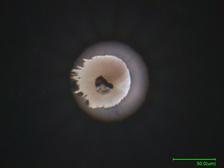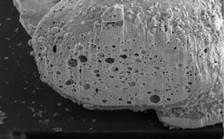Photomicrograph of the sample chamber showing the dispersion of Au within the high-pressure ice, which was caused by X-ray irradiation of the Au foil (Copyright: DESY).
An international team of scientists led by DESY and Yonsei University in Seoul (Korea) has explored new ways of heating high pressure ices in a Diamond Anvil Cell at the X-ray laser PAL XFEL in Pohang (Korea) in order to reach unprecedented temperatures at the pressures commonly found in icy exoplanets. The mantle of exoplanets such as Mini-Neptunes or Uranus are largely composed of planetary ices of H2O, NH3, CH4, and their mixtures. However, the crystal structure, physical properties and phase behavior of these ices at the pressure and temperature conditions of the planetary interior are relatively unknown.
“This is partly due to the fact that these kinds of ices are highly reactive at conditions similar to the planetary interior and cannot be easily contained in high-pressure devices such as the Diamond Anvil Cell”, describes lead author and expert for high-pressure measurements Rachel Husband from DESY. “There has been the idea floating around in the community for the static high-pressure research to use XFEL radiation to heat up the sample quickly to avoid reactions with, and the collapse of the diamonds in the Diamond Anvil Cell”.
In their study, the team surrounded a piece of gold (Au) foil with water in the sample chamber of a Diamond Anvil Cell and compressed it to pressures of 60,000 times atmospheric pressure. At these pressures, the water forms ice crystals with melting temperatures above 1000 K. Using the extremely intense X-ray beam of PAL XFEL, they heated up the Au foil to temperatures in excess of 50,000 K for a very short time (10th of picoseconds). The extreme temperatures induced in the Au foil by the X-ray radiation heated the surrounding ice by thermal conduction, and the Au foil as well as the ice started to melt and mix mechanically with each other. Fast cooling of the sample to room temperature resulted in droplets of H2O remaining trapped inside tiny pores in the Au foil, each with an average diameter of 50-100 nm. The yellow color of the high-pressure ice hints that fine particles of Au were in turn dispersed into the ice.
“All of the evidence pointing to melting and simultaneous mixing of ice and gold during our experiments are indirect in nature so far, because the time between subsequent X-ray pulses at PAL-XFEL is too long to probe the high temperature state in a pump and probe fashion” pointed out sub-project leader Hanns-Peter Liermann from DESY. "However, we have confidence that the pulse repetition rate of the European XFEL in Schenefeld is short enough to see this unique icy gold mixture in its natural habitat in the future.”
The study is related to research of the Research Unit FOR 2240 funded by the DFG and as such also part of the research in the Centre for Molecular Water Science (CMWS) that is currently being set up at DESY.
Original publication:
X-ray free electron laser heating of water and gold at high static pressure, R. J. Husband et al., Communication Materials, 2021; DOI: 10.1038/s43246-021-00158-7








